1984 F-150 302 Windsor 2WD - "Old Red"
Re: 1984 F-150 302 Windsor 2WD - "Old Red"
|
Administrator
|
Swapping the power valve requires the removal of the carb, but once it is off you just turn it upside down and pull the cover to the PV. So there's not much to go wrong save for not getting the gasket on the PV correctly or the gasket on the lid not being on right.
Here's a really poor pic of the two different types of power valve covers. The top one should be the one you have with internal passages, and the bottom one has an external hose that goes to the intake manifold for vacuum. 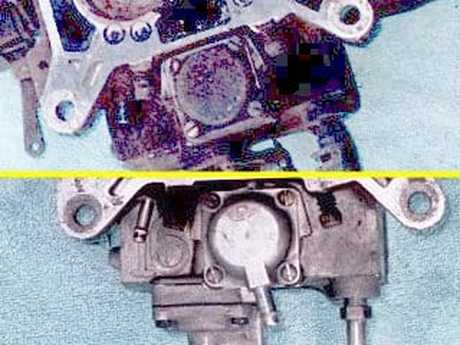
Gary, AKA "Gary fellow": Profile
Dad's: '81 F150 Ranger XLT 4x4: Down for restomod: Full-roller "stroked 351M" w/Trick Flow heads & intake, EEC-V SEFI/E4OD/3.50 gears w/Kevlar clutches
|
Re: 1984 F-150 302 Windsor 2WD - "Old Red"
|
This post was updated on .
Thanks Gary! That's one of the images I've been using as a reference :)
As you might've guessed, I haven't yanked the carb before. Was concerned I was going mess something up and have to recalibrate everything - I'll just have to be careful. Now to find the rebuild kit I bought. Its in one of these boxes labeled parts...hopefully it's actually in the one that says "Truck Parts" 
1984 F-150, 302 CID (5.0 L) Windsor V8, 2 BBL carb, power windows added, remote entry added. AC. Automatic Transmission.
|
Re: 1984 F-150 302 Windsor 2WD - "Old Red"
|
Replaced that hose and the occasional small fuel leak on the manifold is gone (still need to pull the carb and replace the power valve).
I hadn't driven the truck in about 3 weeks, jumped in it on Monday and low and behold had it running in under a minute! After it warmed up - I drove it about 30 miles to a family member's house to pick up some furniture. Ran great! Oddities started to occur when I got back in to start it up after loading it (and visiting with family of course). Turned the key and engine turned over once, hesitated and then turned over a couple more times and then caught. Drove back 30 miles, stopped at the gas station to fill the front tank. Same thing when I went to start the truck. Turn the key, one turn, a second of hesitation and then it turned over again and fired. Got home (2 miles later), parked it. On a whim I figured I would see what happened when I tried to start it. Very slow, weak starting - like the battery was near flat. No signs of power loss while operating the truck. Never got it to start. Popped hood, thought I smelled an electric burned smell over by the battery (where the solenoid is). Let vehicle sit a day or two - went back out and it cranked strong and the motor caught after 2 or 3 cranks. I let it idle for 20 minutes or so while I worked on something else. Shut it off and it started right back up with half a second of hesitation. So - I'm at a loss as to what might be causing this. Thoughts on what to check?
1984 F-150, 302 CID (5.0 L) Windsor V8, 2 BBL carb, power windows added, remote entry added. AC. Automatic Transmission.
|
Re: 1984 F-150 302 Windsor 2WD - "Old Red"
|
Administrator
|
I think you have a poor connection. That might be the end of the cable to the battery or the relay, or it might be the wire inside to the end of the cable - meaning the terminal.
My first thing to do would be to check that all of the connection are clean. Pull the cables off and make sure everything is clean, and the connection are tight when you put them back. But if you have that problem again then gingerly check for a hot connection. Feel the end of the cable near the connection. Is it hot or warm? If so, that cable is bad.
Gary, AKA "Gary fellow": Profile
Dad's: '81 F150 Ranger XLT 4x4: Down for restomod: Full-roller "stroked 351M" w/Trick Flow heads & intake, EEC-V SEFI/E4OD/3.50 gears w/Kevlar clutches
|
Re: 1984 F-150 302 Windsor 2WD - "Old Red"
|
Thanks Gary! I'll have to check - the positive cable from battery to relay definitely is a bit rough looking and likely needs replacement....but first I'll do like you said and check the connections. I swear I could hear a kinda crinkling noise like when plastic melts or burns up after the last attempt to start the truck on Monday (where it just wouldn't fire).
1984 F-150, 302 CID (5.0 L) Windsor V8, 2 BBL carb, power windows added, remote entry added. AC. Automatic Transmission.
|
Re: 1984 F-150 302 Windsor 2WD - "Old Red"
|
Administrator
|
There is another potential problem - the starter. As the bearings in a starter wear the armature gets closer and closer to the field laminations until it finally touches. But it first touches when the starter is hot, like from driving. And when it touches it slows the starter, so the engine doesn't spin very well, and it draws a LOT more current. So that fits some of your symptoms.
However, that doesn't fit the smell and noise. But, a worn starter puts a much larger load on the battery & starter cables, so if they are marginal you'll have a problem there as well.
Gary, AKA "Gary fellow": Profile
Dad's: '81 F150 Ranger XLT 4x4: Down for restomod: Full-roller "stroked 351M" w/Trick Flow heads & intake, EEC-V SEFI/E4OD/3.50 gears w/Kevlar clutches
|
Re: 1984 F-150 302 Windsor 2WD - "Old Red"
|
Administrator
|
If you have a meter that will record a peak reading you can set it up for voltage drop.
This can make internal resistance of a cable or component a lot easier to find.
Jim,
Lil'Red is a '87 F250 HD, 4.10's, 1356 4x4, Zf-5, 3G, PMGR, Saginaw PS, desmogged with a Holley 80508 and Performer intake. Too much other stuff to mention. |
Re: 1984 F-150 302 Windsor 2WD - "Old Red"
|
Alrighty - follow up!
I replaced the positive lead from the battery to the relay and cleaned the connections... Hooked up the starter trigger and clicked it. Sparks shooting from the negative side of relay!  I guess the loose end was on the negative side. It was throwing sparks like a welder! (Which is basically what it was doing ) I guess the loose end was on the negative side. It was throwing sparks like a welder! (Which is basically what it was doing )
I disconnected everything, cleaned the surfaces and put it back together. Truck started cranking like it was supposed to. Right now letting it just idle while supervising kids playing in the driveway. Positive cable is not hot or warm to the touch. Negative is a bit though. Speaking of starters - I have noticed some... Over run (?) Of the starter after the engine starts. A quick grinding noise and then it stops.
1984 F-150, 302 CID (5.0 L) Windsor V8, 2 BBL carb, power windows added, remote entry added. AC. Automatic Transmission.
|
Re: 1984 F-150 302 Windsor 2WD - "Old Red"
|
Administrator
|
Bendix getting sticky and not retracting?
Jim,
Lil'Red is a '87 F250 HD, 4.10's, 1356 4x4, Zf-5, 3G, PMGR, Saginaw PS, desmogged with a Holley 80508 and Performer intake. Too much other stuff to mention. |
Re: 1984 F-150 302 Windsor 2WD - "Old Red"
|
This post was updated on .
Got the carb pulled off - are the nuts supposed to be that easy to take off? Barely took any leverage to break them free. The fuel line from the fuel filter took much more gusto! (Probably a good thing)
Looking at the spacer gaskets between the carb and the intake, I'm wondering if the one that goes from intake to EGR (?) spacer has ever been replaced. 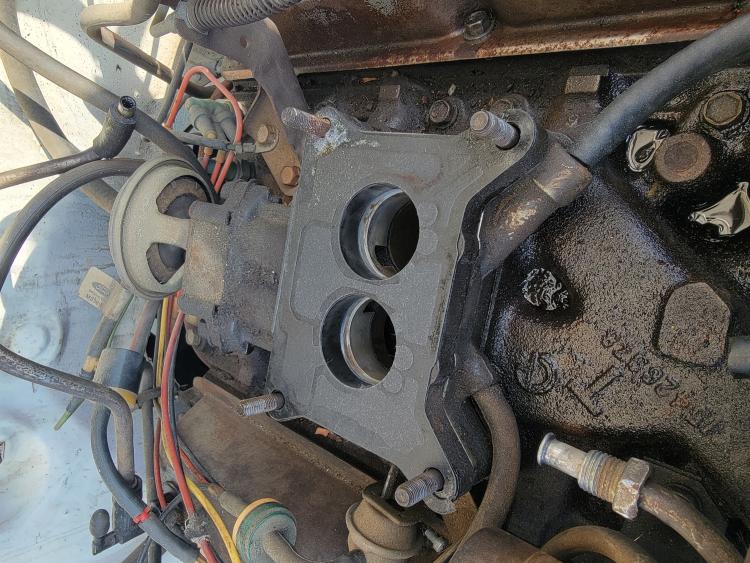 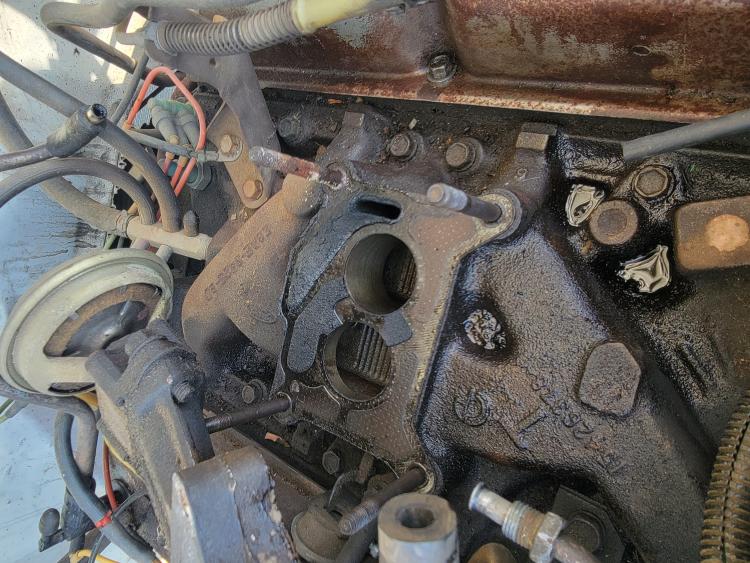 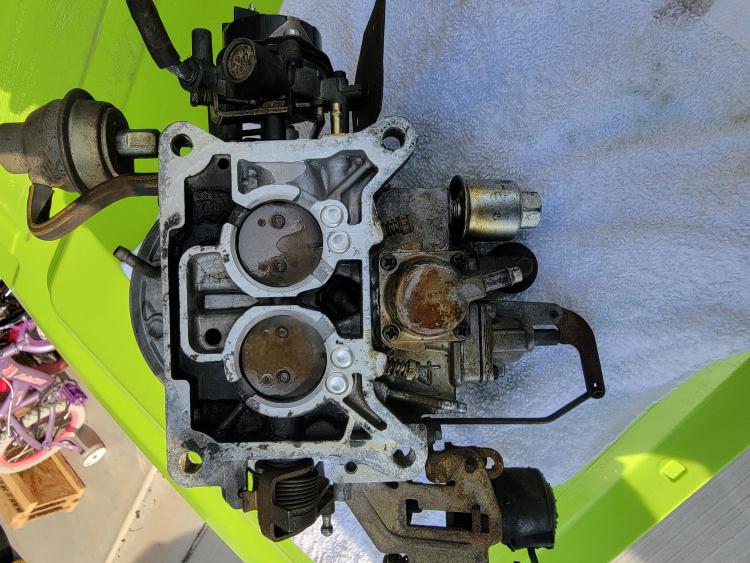
1984 F-150, 302 CID (5.0 L) Windsor V8, 2 BBL carb, power windows added, remote entry added. AC. Automatic Transmission.
|
|
the carb mounting bolts are a mystery to some. as far as how tight? tight enough!
seriously though we have to remind ourselves that there is a soft gasket between the egr plate and intake with a high temp core because it is really an exhaust gasket after all. then there is the 1/4" thick gasket between the egr plate and carb. then the soft metal carb throttle plate. snug on a good gasket is all you want. too tight and you run the risk of breaking an ear off the carb. snug and evenly tightened and I always do a criss cross tightening pattern myself |
Re: 1984 F-150 302 Windsor 2WD - "Old Red"
|
Thanks Mat - I saw there was a difference in the material type of the gasket when looking at the intake/egr plate gasket and then between the egr plate/phenolic spacer and spacer/carb. I'll probably at a minimum swap out the one between the egr plate and the intake - it honestly looks like it's been there a while.
Later this summer, when my garage is cleaned out, I'm going to likely pull the intake and put in some fresh gaskets there and the do the valve covers as well. Half tempted to swap in dual plane intake so I can go to a 4bbl or a efi kit. Glad you mentioned the criss-crossing - that's exactly what I did as well. I saw there was some contention on the forums about how tight. I got them snug without going too tight and left it at that. Biggest concern for me was the fuel leak from the power-valve. Got what is supposed to be the right 2-stage for my carb (E4TE-AKA) and swapped it in. The power valve that was in there was not very tight after all either - so that might've been the cause of my leak.
1984 F-150, 302 CID (5.0 L) Windsor V8, 2 BBL carb, power windows added, remote entry added. AC. Automatic Transmission.
|
|
certainly, we don't want fuel leaks of any kind. sure, there is the fire hazard thing but who really wants to waste it at 4-5 dollars per gallon? but the truth is that in this system 7 psi is really all you are trying to contain. if that much. a strong mechanical pump would be 7-9psi and usually a holley will manage that much pressure, but the ford factory might be more in the 5-7 range. tighten fuel fittings snug at first and check them at running pressure and only tighten more to seal and that's it. use new gaskets and or thread tape as needed but too often we 'crank' fittings way too tight and actually do damage. no need.
|
Re: 1984 F-150 302 Windsor 2WD - "Old Red"
|
mat - agreed that we don't want a fuel leak. The fittings I'm talking about were barely even finger tight - especially the Power Valve. So far, so good - no leaks from the power valve cover going to the Ported Vacuum on the intake!
Somehow the lead from the starter relay to the starter got loose again - this time the bottom nut. Got home and parked after taking it for a drive to the hardware store and realized I needed to back the truck up some more. Wouldn't turn over - popped the hood, moved the lead a little bit to make sure it was snug at the moment and the truck turned over immediately. Haven't driven it this weekend, originally we were supposed to go drive up and buy a Bronco but the seller sold it out from under me. Gotta love the lack of integrity. Back to the drawing board on that one. Old Red is enough of a project at times as it is! I ordered new gaskets to go between: -EGR spacer and Intake (FEL-PRO 60528) -2x Carb to spacer gaskets to go between carb base and phenolic spacer and then phenolic to EGR spacer. These suckers are thick though! They're FEL-PRO 60716's, I was expecting thin papery style gaskets like what was on the engine already. Has anyone used them? I may have ordered the wrong thing for those two. The EGR to Intake is correct!
1984 F-150, 302 CID (5.0 L) Windsor V8, 2 BBL carb, power windows added, remote entry added. AC. Automatic Transmission.
|
|
it is not uncommon for the factory style carb gasket to be a thick one. approx 1/4".
|
Re: 1984 F-150 302 Windsor 2WD - "Old Red"
|
This post was updated on .
Working on the truck again after getting it back from the body shop - I had them address some rust in the fenders and cab corner that I wanted to take care of before it got really bad. They even cut and polished the truck at the end - looks awesome.
Now I'm doing the PMGR starter swap (great instructions btw Gary!). Question - which terminal does the fusible link go to? On the original 3 post relay, turns out the link was on the terminal going to the starter. I replicated that but figured I should ask the more knowledgeable folks here. I saw in the photos on the PMGR instructions that it looked like the link was on the battery side terminal of the relay. About to go under the truck and do the starter swap, figured I'd ask about this before I just try to crank it over and fuse that link... EDIT: Never mind my queastion - I went and looked at the photo I took of the original relay and saw the fuse was actually on the battery side post and moved the link. Truck turned over readily and I eventually got it to start with enough foot pumps. (It'd been sitting a couple weeks)
1984 F-150, 302 CID (5.0 L) Windsor V8, 2 BBL carb, power windows added, remote entry added. AC. Automatic Transmission.
|
Re: 1984 F-150 302 Windsor 2WD - "Old Red"
|
Administrator
|
Refresh me on what "fusible link" you're talking about?
With a PMGR the starter cable moves to the battery side of the fender relay and the starter trigger goes on the switched side (that used to be the starter cable attachment)
Jim,
Lil'Red is a '87 F250 HD, 4.10's, 1356 4x4, Zf-5, 3G, PMGR, Saginaw PS, desmogged with a Holley 80508 and Performer intake. Too much other stuff to mention. |
Re: 1984 F-150 302 Windsor 2WD - "Old Red"
|
Jim - it was the yellow/black lead coming off the battery side of the relay with a fusible link in it. I think I saw in one of the diagrams or discussions that it goes to the ignition.
I double checked the photo I took before I took anything apart and realized that the link was on the battery side terminal of the original 3 post. Got it all buttoned up and have to say, that the difference in effort to spin the engine is noticeable! Cranking for a solid 30 seconds didn't start to slow down or run down the engine. Had a bit of an issue restarting to the truck after I got it running but I think that was a fuel supply issue because a light feather of the throttle when I turned the key got it to turn over and stay running.
1984 F-150, 302 CID (5.0 L) Windsor V8, 2 BBL carb, power windows added, remote entry added. AC. Automatic Transmission.
|
Re: 1984 F-150 302 Windsor 2WD - "Old Red"
|
Administrator
|
Black/orange perhaps?
That would be the charge cable from the alternator or the shunt . 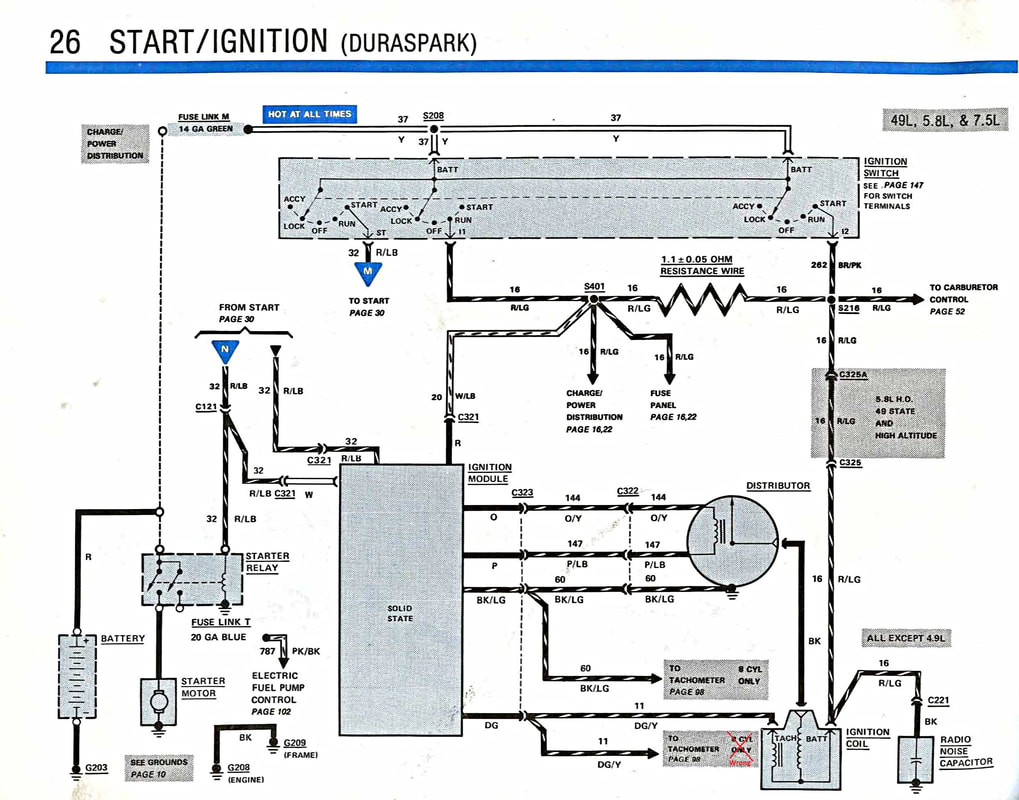  All these trucks never had anything attached with the starter cable. All fusible links go to the battery side.
Jim,
Lil'Red is a '87 F250 HD, 4.10's, 1356 4x4, Zf-5, 3G, PMGR, Saginaw PS, desmogged with a Holley 80508 and Performer intake. Too much other stuff to mention. |
Re: 1984 F-150 302 Windsor 2WD - "Old Red"
|
Yeah I looked at it again - it was definitely once Orange and Black. Got it all buttoned up and running. I'm blown away by how much lighter the new starter is from the OEM one that was in there.
1984 F-150, 302 CID (5.0 L) Windsor V8, 2 BBL carb, power windows added, remote entry added. AC. Automatic Transmission.
|
| Edit this page |

